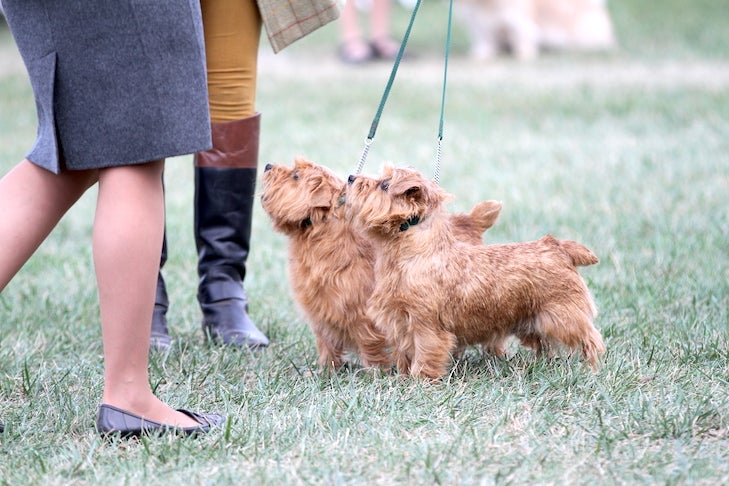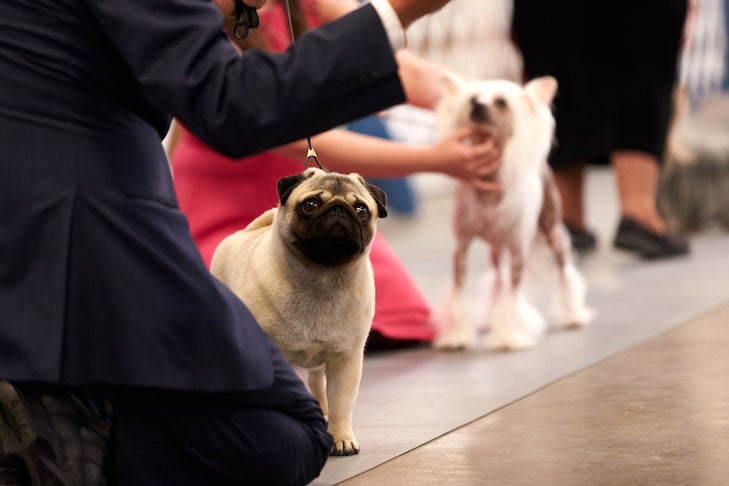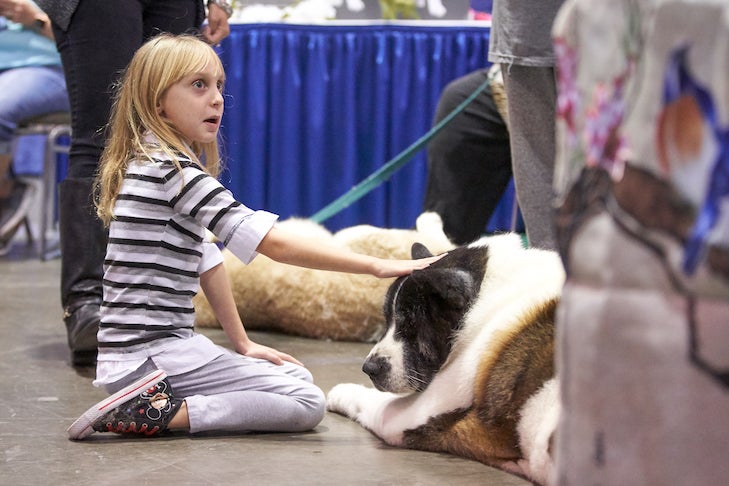
The first step in navigating any culture is learning its etiquette: Never blow your nose at the dinner table in Japan, avoid public displays of affection in Sweden, and expect to encounter close talkers in Spain.
A vibrant subculture in its own right, the dog-show world also has unspoken rules of conduct that might not be obvious to first-timers. Add to that the blur of activity that is the average dog show, and it’s understandable that newbies might be confused about how to act and what to do in this sometimes chaotic, fur-filled world.
In the spirit of demystification, here is some insight into the awkward questions that many newcomers to dog shows want to ask … or, perhaps, never even thought to.
Timing is everything
Dog shows vary in size, from multi-day spectacles like the AKC’s sprawling championship show in Orlando each December, to sleepy local shows that might only attract a couple of hundred dogs. But no matter their scope, shows must be well organized: Without a slavish adherence to the published judging program, they would go on indefinitely.
Because there are no do-overs or time-outs when it comes to that schedule, handlers are exquisitely attuned to “ring times.” Even if they arrive at the right ring at the right time, they still need to pay attention to when their “class,” or the group of dogs with which they compete, goes into the ring.
Awareness of this dog-show rhythm will help you choose the best time to ask questions and interact with handlers – usually, after they are done showing and any competitive tension has subsided, at least temporarily. Be aware of the openings to rings as well as the width of aisles so you don’t block traffic flow. And starting off any conversation with “Is now a good time to talk?” gives handlers the opportunity to let you know if you’ve just stumbled into a pressure-cooker moment.

Territorial imperative
Dog shows are great places to explore, from vendor setups selling squeak toys and elaborate collars to information booths run by various rescues and charities. That said, there are some areas that are inaccessible to exhibitors and spectators alike. Topping the list are the rings – unless an exhibitor is called into the ring by the ring steward (sort of a judge’s helper who keeps the ring running smoothly) or judge, that space delineated by the white accordion ring gates is off-limits. (No, sorry, you can’t sprint across a ring to get where you want to go more easily, even if there is a lull in the action.)
Similarly, the judges‘ hospitality tent is restricted to officials. That’s not just to keep show-goers from raiding the complimentary breakfast and lunch spreads, but also to discourage fraternizing between judges and exhibitors, which, even if perfectly innocent, can lead to the perception of conflicts of interest.
No fuss, no muss
Dogs come in an amazing array of coat lengths, textures, and trims, some of which require far more maintenance than others. While a German Shorthaired Pointer or Great Dane is essentially “wash and wear,” more elaborately coiffed dogs might take hours of primping to ready them for the ring. So be aware of time that went into sculpting that Poodle before you tousle its topknot. In general – but especially with coated breeds – it’s good etiquette to ask, “May I pet your dog?” before getting up close and personal.

No fraternizing
Dog-show rules typically prohibit unentered dogs on the show grounds. There’s good reason for this: Show dogs of very different ages, sizes and temperaments are able to amicably share a show’s sometimes tight quarters because their handlers do not permit them to make contact – no matter how benign – with other dogs. Handlers defuse potential conflicts by keeping their dogs on short leashes, distracting them with toys and treats, and avoiding obvious triggers — like allowing two males to stare each other down. Eventually, this respect for the boundaries of others becomes second nature for most show dogs.
By contrast, dogs that are unaccustomed to shows can be overwhelmed by the sheer quantity of dogs as well as all the activity, and frequently will bark, whine, lunge – or worse. Rather than frustrating your dog – and, by extension, everyone else around him – the better option is to leave your beloved pet at home, with the promise that you’ll tell him all about what he missed when you return.
You kidding?
Show dogs are typically very well socialized; they have to be, in order to allow a perfect stranger – that would be the judge – to open their mouth and feel their entire body. But not all have been exposed to small children, and you can’t assume that every dog at the show will be comfortable tête-à-têting with your toddler.
As a result, don’t permit children to run around the show without close supervision. Rather than pushing babies and small children in strollers through crowds of dogs, hold them in your arms, where they will feel more secure and won’t be at eye level with a bunch of lolling tongues and panting mouths.
If you inquire about greeting a friendly dog and the handler says yes, remind your children that dogs don’t express affection the way humans do: Hugging is never a good idea with a dog, even your own.

Swearing off
Even a glance around a dog show tells you that many of the norms of bygone years are still very operative in this sport: Male handlers dress formally, in blazers and ties, only removing them on hot summer days if the judge has done so first. Judges and exhibitors refer to each other as “sir” and “ma’am.” And the use of profane language is expressly prohibited, with onlookers able to request a hearing to punish an offender if a blue streak is overheard.
As a result, salty language isn’t appropriate at dog shows, even if you’re not one of the participants. The one glaring exception is the word “bitch” – at least when used as a noun. Dog shows, after all, use that word as it was originally intended – as a description of a female dog – and all the names of classes for female dogs at shows include it. Hearing the “B word” used so blithely – and so frequently – might make you wince, but it’s just part of the dog-show vernacular. Best to get used to it.
Puppy love
There’s no better place than a dog show to see a large variety of breeds – some of which you likely never knew existed – especially if you’re thinking of adding a purebred dog to your household.
Don’t, however, expect to find puppies for sale at shows. Not only is that a potential health risk, as young puppies are not yet fully vaccinated, but it’s also against AKC rules.
Instead, invest $5 or so in the printed show catalog, which lists the names of the owners and breeders of dogs exhibited that day. Mark the dogs in those pages that appeal to you, and even if you don’t get a chance to talk to the handler, you can do an Internet search for the breeder, and contact him or her to find out about plans for upcoming litters.
And if you found your first dog show even the slightest bit interesting, be open to the possibility of getting a show prospect. Most breeders are more than willing to take newbies under their wing, and there’s nothing more satisfying than showing your own dog. Besides, now that you’ve read this far, you already know the ropes.

